In recent years, the world of finance has experienced significant transformations driven by blockchain technology and decentralized finance (DeFi). One of the emerging concepts gaining attention is Regenerative Finance (ReFi). This model focuses on creating a more sustainable, ethical, and impactful financial ecosystem that nurtures long-term growth, values, and environmental stewardship. But what is ReFi, how ReFi works and why is it gaining traction in the blockchain and Web3 ecosystem?
Regenerative Finance (ReFi) is a relatively new term in the crypto world, evolving as an ethical and environmentally conscious alternative to traditional financial models. While cryptocurrencies and decentralized finance (DeFi) offer innovative ways to conduct transactions, Regenerative Finance (ReFi) aims to go a step further by embedding sustainability and positive societal impact into the financial system itself. As concerns about climate change, wealth inequality, and financial exclusion grow, traditional finance struggles to provide solutions. This is where Regenerative Finance comes in—offering a new approach that aligns financial incentives with social and environmental well-being.
In this blog, we’ll dive deep into what is Regenerative Finance (ReFi) and how ReFi works, how it integrates with blockchain and crypto, and why it’s set to revolutionize decentralized cryptocurrency exchange development. If you are looking for how to build a decentralized exchange like Uniswap or leveraging AI-powered crypto exchange development, the rise of ReFi represents a shift toward a more sustainable and inclusive financial ecosystem. Whether you’re exploring centralized crypto exchange development or the best White Label Crypto Wallet Development, understanding Regenerative Finance (ReFi) and how Regenerative Finance works is key to shaping the future of finance.
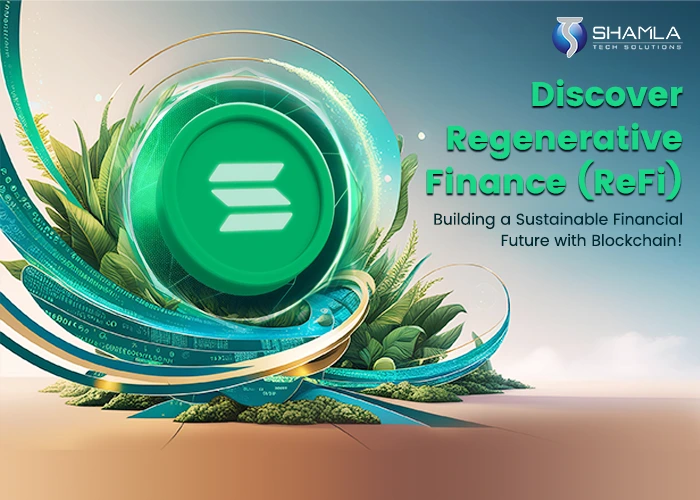
What Is ReFi?
ReFi (Regenerative Finance) is a financial model designed to prioritize sustainability, social impact, and equitable wealth distribution alongside economic returns. But what is ReFi, how ReFi works, and how does it differ from traditional finance?
Unlike conventional financial systems, which often contribute to wealth inequality and environmental harm, Regenerative Finance creates self-sustaining, positive-feedback economic loops that actively restore resources rather than depleting them. ReFi promotes eco-friendly investments, fair lending practices, and community-driven wealth generation.
At its core, ReFi leverages blockchain technology to build transparent and decentralized economic systems. By integrating carbon credit tokenization, decentralized autonomous organizations (DAOs), impact staking, and biodiversity assets, ReFi ensures that financial transactions contribute to global well-being.
As crypto and Web3 evolve, Regenerative Finance is redefining how money flows, encouraging businesses and individuals to participate in financial models that regenerate, rather than exploit, our world. Understanding what is ReFi and how Regenerative Finance works will be key to embracing a new financial ecosystem that promotes both financial returns and positive societal impacts. Bottom of Form
The Rise of ReFi in the Crypto Space
The rise of blockchain and decentralized finance (DeFi) has transformed traditional financial systems, offering greater transparency, accessibility, and efficiency. However, while DeFi has democratized finance, it has largely remained profit-driven, focusing on yield farming, lending, and trading without addressing sustainability or long-term impact. This has led to growing concerns about wealth concentration, high carbon footprints, and economic instability within crypto ecosystems. Understanding what is ReFi and how ReFi works is key to this sustainable shift.
Why the Crypto Space Needs Regenerative Finance (ReFi)
As global issues like climate change, financial exclusion, and economic inequality intensify, the need for sustainable and inclusive financial models has become more urgent. What is ReFi? It is a response to these challenges, integrating blockchain technology, smart contracts, and tokenized impact assets to create financial systems that actively regenerate and restore instead of merely extracting value.
The Role of Web3 in Accelerating ReFi Adoption
Web3 technologies have catalyzed the growth of Regenerative Finance by enabling decentralized governance and transparent, impact-driven funding mechanisms. How does Regenerative Finance work in Web3? Innovations like carbon credit tokenization and DAOs allow for aligning financial incentives with climate-positive actions, circular economies, and fair wealth distribution. Web3 facilitates a more inclusive and regenerative financial ecosystem, ensuring that investments promote both profit and positive social change.
Increasing Interest from Investors and Institutions
As ESG (Environmental, Social, and Governance) investing gains traction, ReFi has captured the attention of institutional investors. What is Regenerative Finance and how does it attract institutional interest? ReFi’s blend of financial returns and real-world impact makes it an appealing choice for investors who want to drive change. With ReFi’s ability to merge profit with purpose, it’s rapidly becoming a focal point for both investors and developers building a sustainable future in crypto.
The rise of Regenerative Finance signals a shift from speculative, extractive models to purpose-driven systems in the crypto space. How Regenerative Finance works can be seen through its alignment of financial activities with long-term sustainability. Blockchain’s transparency, automation, and decentralized governance are core to this evolution. ReFi is set to redefine finance by ensuring economic growth is intertwined with environmental and social well-being.
How ReFi Differs from DeFi
The emergence of Decentralized Finance (DeFi) has reshaped the financial ecosystem by providing permissionless access to financial services, eliminating intermediaries, and increasing liquidity. However, DeFi remains largely focused on profit maximization, often benefiting those who can leverage its mechanisms for financial gain.
What is ReFi? Regenerative Finance (ReFi) is a blockchain-based approach that ensures financial systems contribute to sustainability, climate action, and equitable wealth distribution. How Regenerative Finance works is by prioritizing long-term positive impact rather than short-term returns, creating economic models that regenerate both society and the environment.
Let’s explore the key differences between DeFi and ReFi to understand how each contributes to the future of finance.
Aspect | DeFi (Decentralized Finance) | ReFi (Regenerative Finance) |
Core Purpose | Decentralization, financial inclusion, and efficiency. | Regenerating ecosystems, sustainability, and social impact. |
Financial Model | Profit-driven, liquidity-focused, encourages speculation. | Circular economies, fair wealth distribution, impact-driven. |
Wealth Distribution | Benefits early adopters, large liquidity providers, and traders. | Ensures equitable wealth distribution by funding regenerative initiatives. |
Environmental Impact | High energy consumption (PoW), lacks focus on sustainability. | Supports climate action, carbon credits, and eco-friendly projects. |
Incentive Mechanism | Rewards liquidity providers and stakers with high yields. | Rewards participation in sustainability and regeneration efforts. |
Use of Smart Contracts | Automates lending, borrowing, and trading transactions. | Automates impact-driven finance, enforcing transparency and accountability. |
Governance Model | DAOs focused on financial protocol decisions and yield maximization. | DAOs prioritizing ESG goals and sustainability in governance decisions. |
Community Focus | Investors, traders, and liquidity providers. | Social entrepreneurs, climate advocates, and sustainability-focused individuals. |
While DeFi has democratized access to financial services, it remains heavily profit-oriented, benefiting those who can leverage its mechanisms effectively. ReFi, on the other hand, represents a shift toward a finance model that balances economic incentives with real-world regeneration. How Regenerative Finance works involves integrating sustainability, fairness, and blockchain innovation to create financial systems that actively restore and regenerate resources.
By integrating sustainability, fairness, and blockchain innovation, ReFi is not just a new sector of crypto—it’s a movement towards a more inclusive, regenerative financial future.
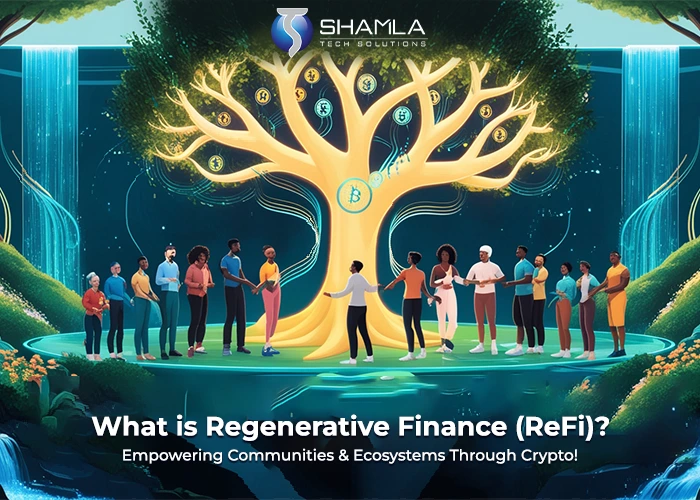
Core Components of a ReFi Ecosystem
Regenerative Finance (ReFi) are transforming the financial landscape by prioritizing sustainability, equitable wealth distribution, and long-term positive impact. Regenerative Finance (ReFi) represent a financial framework built on blockchain technology, supporting economic activities that benefit both people and the planet. Unlike traditional finance, which often focuses on profit maximization at the expense of natural and social resources, Regenerative Finance (ReFi) introduce a self-sustaining financial ecosystem that regenerates what it uses.
A successful ReFi ecosystem consists of several core components that ensure transparency, decentralization, and regenerative financial flows. These elements create a circular economy where value is continually reinvested in positive-impact projects, driving real-world improvements in environmental and social well-being.
Tokenized Assets for Sustainability
Tokenization plays a crucial role in Regenerative Finance (ReFi) by converting real-world impact assets into blockchain-based financial instruments. This enhances liquidity, transparency, and accessibility, making it easier for individuals and organizations to participate in regenerative initiatives. Tokenized assets in Regenerative Finance (ReFi) can include carbon credits, regenerative NFTs, and impact-backed stablecoins. By leveraging AI-powered crypto exchange development, tokenized assets can be seamlessly integrated into decentralized finance platforms, ensuring wider adoption and impact.
Decentralized Impact DAOs
Decentralized Autonomous Organizations (DAOs) form the governance structure of Regenerative Finance (ReFi) and its works, enabling community-driven funding and decision-making. Unlike centralized financial institutions, DAOs operate on smart contracts, ensuring transparency and accountability. Through these decentralized governance mechanisms, Regenerative Finance (ReFi) facilitate fair and democratic distribution of funds. Organizations exploring how to create a decentralized cryptocurrency exchange can integrate DAOs to ensure ethical financial flows.
Regenerative Yield Mechanisms
Regenerative Finance (ReFi) incorporate yield mechanisms that incentivize sustainability-focused financial behaviors. Unlike traditional yield farming, which prioritizes speculative profits, these yield mechanisms reward activities that contribute to climate action and social equity. By leveraging AI-powered crypto exchange development, decentralized finance platforms can integrate staking mechanisms that support regenerative finance principles. Organizations looking into how to build your own decentralized exchange can incorporate sustainable yield incentives for liquidity providers.
Blockchain-Based Verification and Transparency
One of the significant challenges in sustainability finance is the risk of greenwashing, where companies falsely claim environmental benefits. Regenerative Finance (ReFi) utilize blockchain technology to create verifiable, immutable records of impact. Smart contracts ensure real-time tracking of sustainability initiatives, allowing for transparent verification of impact. This aspect is crucial for cryptocurrency exchange development and centralized crypto exchange development companies aiming to build trust within their user base.
Circular Economic Models
Regenerative Finance (ReFi) promote circular economy models where financial value is continually reinvested into regenerative activities rather than being extracted for short-term profits. This approach aligns with sustainable finance principles by supporting universal basic income (UBI) models, regenerative revenue-sharing structures, and waste-to-value financial frameworks. Businesses exploring how to build a decentralized exchange like Uniswap can integrate circular financial mechanisms to ensure sustainability.
Regenerative Lending and Credit Systems
Traditional lending models often exclude unbanked individuals due to strict credit requirements. Regenerative Finance (ReFi) introduce decentralized lending mechanisms that prioritize social and environmental impact. These models include social and environmental credit scoring, zero-interest microloans, and crowdfunded impact loans. By integrating these elements into crypto exchange platform development in the USA, financial accessibility can be expanded to underserved populations.
Community-Driven Governance and Participation
Regenerative Finance (ReFi) emphasize collaborative decision-making, preventing centralized control over financial resources. Community-driven governance mechanisms such as quadratic voting and grant programs empower individuals to contribute to sustainable financial solutions. These governance models can be embedded in best white-label crypto wallet development initiatives, ensuring user engagement and decentralized financial decision-making.
As the demand for financial sustainability grows, understanding how to create a decentralized exchange and how to develop AI-powered crypto exchange solutions will be crucial for shaping the future of finance. The best crypto exchanges in the USA 2024 and the best crypto exchanges in the UK 2024 will likely adopt elements of Regenerative Finance (ReFi) to enhance transparency, inclusivity, and long-term value creation. By incorporating regenerative financial principles, centralized crypto exchange development companies can ensure that financial systems serve both economic and environmental objectives.
How Blockchain Supports Regenerative Finance (ReFi)
Regenerative Finance (ReFi) is revolutionizing the financial ecosystem by aligning financial incentives with sustainability, social equity, and long-term economic resilience. Unlike traditional finance, which often prioritizes short-term profits, ReFi leverages blockchain technology to create transparent, inclusive, and self-sustaining economic systems.
Blockchain plays a crucial role in supporting Regenerative Finance (ReFi) by providing a decentralized infrastructure that enhances trust, efficiency, and accessibility. Through decentralized exchanges, tokenized assets, and smart contracts, blockchain eliminates inefficiencies in sustainability finance, ensuring that capital flows directly to regenerative projects.
Key Ways Blockchain Enhances Regenerative Finance (ReFi)
1. Decentralized and Transparent Financial Systems
Traditional financial systems are often opaque, centralized, and exclusionary. Blockchain introduces a decentralized ledger system that ensures financial transactions in ReFi are fully transparent, immutable, and verifiable.
- Transparency: Every transaction is recorded on an open ledger, eliminating corruption and misallocation of funds.
- Decentralization: Funds are distributed through smart contracts and Decentralized Autonomous Organizations (DAOs) rather than intermediaries.
- Real-Time Auditing: Blockchain enables real-time tracking of sustainable finance initiatives, ensuring compliance with environmental and social impact goals.
2. Tokenization of Sustainable Assets
Blockchain enables the creation of tokenized financial assets that represent real-world regenerative projects. This ensures liquidity, accessibility, and inclusivity in sustainability finance.
- Carbon Credits & Climate Tokens: Companies can buy tokenized carbon credits to offset emissions, creating a self-sustaining financial mechanism for environmental restoration.
- Green Bonds & ReFi Tokens: Investors can participate in regenerative finance through decentralized lending platforms where their funds are locked in sustainability projects.
- NFTs for Social & Environmental Impact: NFTs can represent ownership of ecological projects such as reforestation, renewable energy plants, or ocean clean-up efforts.
3. Smart Contracts for Automated Regenerative Finance
Smart contracts eliminate inefficiencies in traditional sustainability finance by automating financial agreements that support Regenerative Finance (ReFi).
- Automated Funding Allocation: Smart contracts distribute funds only when predefined sustainability milestones are met.
- Impact Verification & Compliance: Blockchain ensures funding goes to projects that meet climate and social impact standards.
- Decentralized Credit & Lending Systems: Smart contracts facilitate zero-interest loans for sustainable businesses without the need for intermediaries.
4. Regenerative Yield Mechanisms and Staking
ReFi introduces sustainable yield farming models that reward users for funding regenerative projects. Unlike speculative yield farming, these mechanisms generate long-term positive externalities for the environment and society.
- Impact Staking: Users can stake tokens in sustainability-focused decentralized exchanges, earning rewards based on real-world environmental impact.
- Sustainable Liquidity Pools: Liquidity providers earn interest while supporting projects related to renewable energy, biodiversity, and climate resilience.
- Blockchain-Based Green Bonds: ReFi enables individuals to purchase impact-backed bonds, funding eco-friendly infrastructure while earning fixed returns.
5. Inclusive Financial Access and Decentralized Credit
One of the key challenges in traditional finance is financial exclusion, where underserved communities lack access to credit and capital. Blockchain-powered ReFi protocols democratize finance by introducing decentralized lending models.
- Universal Basic Income (UBI) Tokens: Blockchain-based UBI initiatives distribute income to vulnerable communities without relying on intermediaries.
- Microloans & Zero-Interest Lending: Smart contract-based lending allows small-scale regenerative businesses to access funds with low or zero interest.
- Decentralized Credit Scoring: Borrowers are evaluated based on their contributions to sustainability rather than traditional credit scores.
6. Blockchain-Powered Governance and Community Participation
Governance is a key pillar of Regenerative Finance (ReFi). Blockchain-based Decentralized Autonomous Organizations (DAOs) ensure that financial decision-making is community-driven, democratic, and transparent.
- Quadratic Voting: Prevents financial elites from dominating decisions, ensuring equitable governance.
- ReFi Grant Programs: Crowdsourced blockchain funding mechanisms support sustainable community projects.
- Decentralized Policy Enforcement: ReFi DAOs autonomously enforce sustainability regulations via smart contracts.
Blockchain technology is a critical enabler of Regenerative Finance (ReFi) by providing decentralized, transparent, and verifiable financial infrastructure. Through smart contracts, tokenized assets, impact-driven yield mechanisms, and decentralized governance, blockchain ensures that ReFi projects are not only financially viable but also socially and environmentally impactful.
As the world shifts towards a more sustainable financial model, blockchain will continue to serve as the foundation of Regenerative Finance (ReFi), enabling an inclusive, fair, and regenerative economic future.
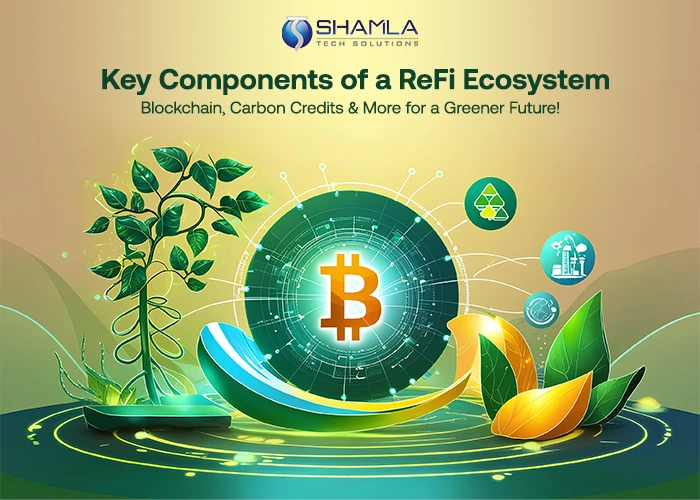
Key Use Cases of Regenerative Finance (ReFi) in Crypto
Regenerative Finance (ReFi) is transforming the financial landscape by integrating sustainability, social equity, and blockchain technology. By leveraging decentralized finance (DeFi), tokenization, and community-driven models, Regenerative Finance (ReFi) enables financial ecosystems that restore value rather than deplete resources. The rise of AI-Powered Crypto Exchange Development further enhances the potential of ReFi by enabling seamless transactions and governance mechanisms. Below are some key use cases demonstrating Regenerative Finance (ReFi) and how it works to shape the crypto space.
1. Carbon Credit Tokenization and Climate Finance
One of the most critical applications of Regenerative Finance (ReFi) is in the area of carbon credit tokenization. Traditional carbon credit markets are often fragmented, inefficient, and difficult to verify. Blockchain technology enables the tokenization of carbon credits, allowing individuals, companies, and institutions to invest in verified carbon offset projects. These digital carbon assets can be traded on decentralized exchanges, improving transparency, liquidity, and access to climate finance solutions.
The role of Crypto Exchange Platform Development in USA in enabling seamless transactions for carbon credit trading is increasing, ensuring that sustainability-focused assets can be integrated into mainstream financial systems.
2. Decentralized Crowdfunding for Sustainable Projects
Another key area where Regenerative Finance (ReFi) are making an impact is in decentralized crowdfunding. Unlike traditional fundraising platforms that rely on centralized financial intermediaries, ReFi-powered crowdfunding platforms leverage blockchain technology to ensure greater transparency, lower costs, and community-driven funding distribution.
With the expansion of Centralized Crypto Exchange Development Company initiatives, decentralized fundraising platforms are being incorporated into hybrid financial models that combine aspects of both centralized and decentralized finance (CeFi and DeFi).
The rise of Best Crypto Exchanges in the UK 2024 has also introduced more options for cross-border fundraising, allowing sustainability-focused projects to reach a global investor base.
3. Regenerative Yield Farming and Staking
Regenerative Finance (ReFi) leverage decentralized finance (DeFi) mechanisms such as yield farming and staking to support environmental and social impact projects. In a regenerative financial ecosystem, staking rewards and transaction fees can be redirected toward initiatives like renewable energy, regenerative agriculture, and conservation projects.
As more investors look for impact-driven opportunities, projects integrating Best Crypto Exchanges in USA 2024 with ReFi-based staking pools are becoming increasingly relevant.
Blockchain-based staking mechanisms, combined with AI-Powered Crypto Exchange Development, are optimizing the efficiency of regenerative yield farming by automating risk management and sustainability-focused asset allocations.
4. Community-Owned Financial Systems and DAOs
Regenerative Finance (ReFi) are driving the creation of community-owned financial ecosystems through Decentralized Autonomous Organizations (DAOs). DAOs empower communities to collectively govern funds, projects, and economic initiatives without reliance on traditional financial institutions.
Blockchain technology ensures transparent decision-making and equitable wealth distribution, which is crucial for funding sustainability projects and community-led economic development initiatives.
With advancements in How to Build Your Own Decentralized Exchange, more community-governed platforms are emerging, allowing local stakeholders to have direct control over their financial futures.
5. Regenerative NFT Marketplaces
NFTs (Non-Fungible Tokens) are commonly associated with digital art, but Regenerative Finance (ReFi) have introduced new applications for NFTs in environmental and social impact projects. By tokenizing real-world assets such as trees, biodiversity credits, and conservation initiatives, regenerative NFT marketplaces enable direct investment into sustainability efforts.
The development of Best White Label Crypto Wallet Development solutions is playing a vital role in integrating regenerative NFTs into mainstream crypto ecosystems, allowing users to securely store, manage, and trade impact-driven digital assets.
6. Decentralized Microfinance and Financial Inclusion
Financial inclusion is a core principle of Regenerative Finance (ReFi) and its works. Traditional banking systems exclude millions of individuals from financial services due to factors like high fees, geographical barriers, and lack of credit history. ReFi-based microfinance platforms use blockchain technology to provide decentralized lending, stablecoin-based savings, and credit scoring solutions that empower underserved communities.
Through How to Create a Decentralized Exchange, financial accessibility is enhanced, allowing users to access capital without dependence on traditional banking intermediaries. The rise of Cryptocurrency Exchange Development has also facilitated the adoption of stablecoins in developing regions, providing economic stability in areas with volatile national currencies.
7. Tokenized Natural Assets and Sustainable Investment
Tokenizing natural assets such as forests, agricultural land, and marine ecosystems allows investors to participate in sustainability-focused financial markets. Regenerative Finance (ReFi) enables the creation of transparent, verifiable, and liquid markets for these assets, ensuring that capital is directed toward regenerative economic activities.
The ability to trade tokenized natural assets through Best Crypto Exchanges in the UK 2024 further expands the accessibility of impact-driven investment opportunities. Additionally, blockchain-based smart contracts ensure that revenue generated from these assets is fairly distributed among stakeholders involved in conservation efforts.
8. AI-Powered Crypto Exchange Development for Impact Investing
The integration of artificial intelligence with Regenerative Finance (ReFi) is transforming impact investing by enabling data-driven decision-making, automated risk assessment, and optimized portfolio management. AI-Powered Crypto Exchange Development platforms are enhancing the efficiency of regenerative investment models by providing insights into sustainability metrics, ESG (Environmental, Social, Governance) scoring, and real-time performance tracking.
With the emergence of How to Build a Decentralized Exchange Like Uniswap, AI-driven trading mechanisms are being adopted to create smart order execution strategies for sustainability-focused digital assets.
9. Gamified ReFi Platforms and Play-to-Regenerate Models
Gamification is being increasingly used to incentivize regenerative financial behaviors. Regenerative Finance (ReFi) are integrating play-to-earn (P2E) and play-to-regenerate (P2R) models, where users are rewarded for engaging in activities that contribute to environmental and social impact.
Decentralized gaming ecosystems, powered by Best Crypto Exchanges in USA 2024, enable players to earn sustainability-backed tokens that can be used for impact-driven projects.
10. Integration with Decentralized Exchange Development and Crypto Wallets
For Regenerative Finance (ReFi) to scale effectively, seamless integration with decentralized financial infrastructure is crucial. The development of Crypto Exchange Platform Development in the USA is facilitating liquidity for regenerative assets, while Best White Label Crypto Wallet Development solutions provide secure storage for impact-driven digital assets.
By leveraging innovations in how to create a decentralized cryptocurrency exchange, regenerative finance projects can ensure that sustainability-focused assets remain accessible, liquid, and widely adopted within the broader crypto ecosystem.
The rise of Regenerative Finance (ReFi) represents a paradigm shift in how financial systems operate. By prioritizing restoration over extraction, sustainability over short-term gains, and equitable wealth distribution over centralized control, ReFi is paving the way for a more inclusive, regenerative, and decentralized financial future. With continued innovation, Regenerative Finance (ReFi) will play a central role in reshaping the global financial landscape.
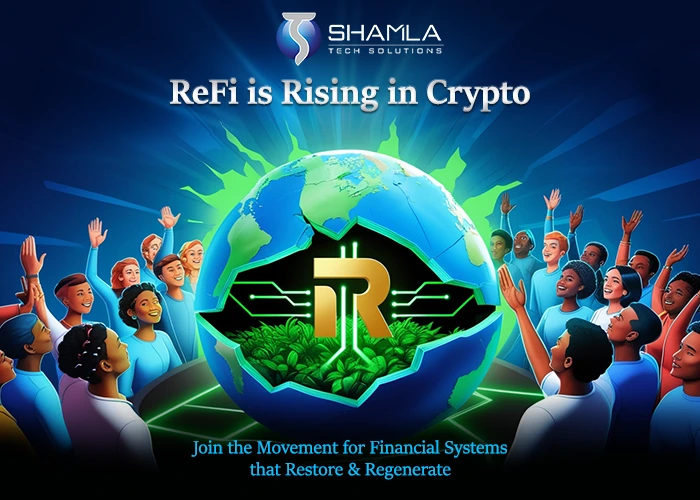
Leading Regenerative Finance (ReFi) Projects
Regenerative Finance (ReFi) is a model that integrates blockchain technology with sustainable economic systems, focusing on environmental and social regeneration. If you’re looking to understand what is Regenerative Finance (ReFi) and how Regenerative Finance works, the following ReFi projects are some of the best examples. They showcase how blockchain can be used to create financial systems that not only generate profit but also focus on sustainability and positive impact. Below are some notable ReFi projects leading the charge in transforming finance for good.
1. KlimaDAO
KlimaDAO is a decentralized autonomous organization (DAO) focused on combating climate change through carbon credit tokenization. By using blockchain technology, KlimaDAO enables individuals and institutions to buy, trade, and retire carbon credits transparently, helping reduce carbon emissions globally.
2. Toucan Protocol
Toucan Protocol builds blockchain-based infrastructure for the carbon credit market, making it easier to integrate carbon offsets into DeFi applications. By tokenizing real-world carbon credits, Toucan Protocol allows businesses and individuals to invest in environmental sustainability while maintaining financial growth.
3. Celo
Celo is a blockchain platform designed to support financial inclusion and environmental sustainability. It enables mobile-friendly financial transactions and supports decentralized applications (dApps) that promote regenerative economic models. Celo’s ecosystem includes projects focused on sustainable agriculture, community banking, and microfinance.
4. Regen Network
Regen Network is a blockchain-powered platform that incentivizes ecological regeneration. It allows farmers, conservationists, and environmental organizations to earn rewards for sustainable land management and carbon sequestration practices. Through verified ecological data, Regen Network ensures that investments contribute to measurable environmental benefits.
5. Flow Carbon
Flow Carbon bridges the gap between traditional carbon markets and blockchain technology. It tokenizes carbon credits, enabling seamless trading and integration with DeFi platforms. By enhancing the accessibility and transparency of carbon credits, Flow Carbon supports global efforts to combat climate change.
6. Solid World DAO
Solid World DAO focuses on providing liquidity for regenerative projects by creating transparent and accessible carbon markets. By addressing liquidity challenges in the carbon credit industry, this project ensures that environmental initiatives receive sustainable funding through blockchain-driven mechanisms.
7. Senken
Senken is a decentralized exchange for carbon credits, allowing companies and individuals to invest in verified carbon offset projects. By leveraging blockchain’s transparency and security, Senken makes it easier for organizations to achieve sustainability goals while ensuring the integrity of carbon offset transactions.
Regenerative Finance (ReFi) is revolutionizing the financial sector by integrating sustainability with blockchain technology. As more projects like KlimaDAO, Toucan Protocol, and Celo emerge, the future of finance is shifting toward models that prioritize environmental restoration and social impact. By leveraging decentralized systems, ReFi creates transparent, equitable, and regenerative economies that benefit both people and the planet.
Challenges Hindering the Adoption of Regenerative Finance (ReFi)
While Regenerative Finance (ReFi) holds great potential to reshape the financial ecosystem by prioritizing sustainability, its adoption faces several obstacles. These challenges are largely related to the differences between traditional finance systems and how Regenerative Finance (ReFi) operates, as well as technical, regulatory, and scalability concerns.
Shifting Mindsets in the Financial Sector
A key challenge in the widespread adoption of ReFi is the shift in mindset required from investors and financial institutions. Traditional finance has long been centered around short-term profits, while ReFi is built on long-term sustainable goals. This divergence can cause hesitation among investors, as they might not see immediate financial returns. As ReFi continues to evolve, educating investors about the long-term benefits and the new financial opportunities it presents will be essential to overcoming this challenge.
Regulatory Uncertainty and Compliance
Another obstacle for ReFi adoption is the lack of regulatory clarity. Many ReFi projects rely heavily on blockchain technology, and the evolving nature of regulations around cryptocurrency and decentralized finance (DeFi) adds a layer of uncertainty. As ReFi is intricately linked with decentralized platforms, ensuring compliance with existing financial regulations while maintaining the core values of how ReFi works is crucial. Without clear legal frameworks, ReFi initiatives might face delays or difficulty attracting institutional participation.
Scalability and Technological Integration
As ReFi projects are often built on blockchain networks, scalability remains a critical concern. The technology behind Regenerative Finance (ReFi) must be able to handle increased transaction volumes and integrate seamlessly with the traditional financial system. ReFi projects can face challenges in scaling up due to blockchain’s current limitations in terms of transaction speed and costs. For ReFi to work on a global scale, overcoming these technical hurdles is necessary to ensure that it can support millions of users and seamlessly integrate with existing financial markets.
Trust and Transparency Challenges
Blockchain technology, the backbone of ReFi, is known for providing transparency, but ensuring that the funds are used for their intended purpose remains a challenge. ReFi projects need to provide robust systems of accountability to ensure that investments in sustainable initiatives, such as carbon credits or ecosystem restoration, actually result in the desired environmental and social outcomes. While ReFi platforms work to prove their transparency, there is still skepticism around whether the true impact of these projects is being realized.
Limited Awareness and Education
One of the barriers to ReFi’s adoption is the general lack of understanding and awareness of how Regenerative Finance works. For ReFi to succeed, there must be more widespread education about the benefits of this new financial model and how it differs from traditional finance. Without educating investors, businesses, and the general public about the long-term benefits and how ReFi integrates financial growth with environmental restoration, many may fail to see the value in participating.
By addressing these challenges, Regenerative Finance (ReFi) has the potential to create a more sustainable and equitable global financial system. However, overcoming these barriers will require cooperation between the blockchain, finance, and regulatory sectors, along with continued efforts to educate stakeholders on the unique benefits of ReFi.
The Role of DAOs in Regenerative Finance (ReFi)
Decentralized Autonomous Organizations (DAOs) play a crucial role in the world of Regenerative Finance (ReFi). DAOs are community-driven, blockchain-based organizations that allow individuals to participate in decision-making processes without the need for traditional intermediaries. In the context of ReFi, DAOs provide a decentralized governance structure that aligns with the principles of sustainability and community impact. Through DAOs, ReFi projects can offer transparent decision-making, ensuring that funds are directed toward regenerative initiatives that benefit both people and the planet. A key aspect of how ReFi works within DAOs is the ability for token holders to vote on proposals related to environmental projects. This decentralized governance system ensures that decisions are made by the community, rather than centralized entities, empowering individuals to directly influence positive environmental and social outcomes.
How Investors Can Get Involved in Regenerative Finance (ReFi)
For investors interested in Regenerative Finance (ReFi), there are various pathways to get involved. Whether through direct participation in ReFi projects or by supporting platforms that align with how ReFi works, investors can play a pivotal role in scaling sustainable finance initiatives. One of the most direct ways to invest in ReFi is by purchasing tokens or assets tied to ReFi platforms that focus on environmental sustainability, such as carbon credits or green energy projects.
Investors can also become part of DAOs governing ReFi projects, allowing them to vote on key decisions that shape the future of sustainability initiatives. By staking tokens or participating in liquidity pools, they can earn rewards while helping fund regenerative initiatives. As the sector matures, more avenues for investing in ReFi will open, and investors can expect to see a growing number of platforms that integrate how ReFi works into their offerings.
Another option for investors is to explore decentralized exchange development, which supports ReFi projects by facilitating transparent trading of ReFi tokens and assets. The integration of AI-Powered Crypto Exchange Development! with ReFi projects provides enhanced trading security, transparency, and efficiency, giving investors more ways to access and support these initiatives.
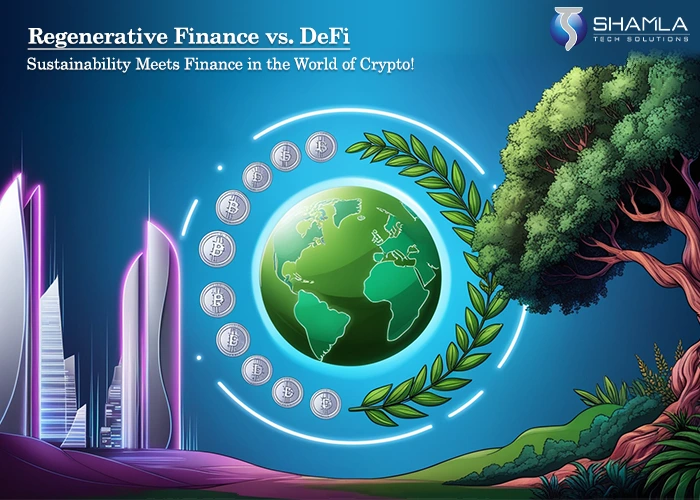
The Future of Regenerative Finance (ReFi) in Crypto
The future of Regenerative Finance (ReFi) in the crypto space is poised for exponential growth as more projects integrate sustainability with blockchain technology. ReFi is shifting the way we think about financial systems, prioritizing long-term environmental and social benefits over short-term profits. By leveraging blockchain’s transparency, security, and decentralization, how Regenerative Finance works will continue to evolve, creating financial ecosystems that directly contribute to global ecological restoration.
As the market matures, we can expect ReFi to become more embedded in mainstream finance. More organizations will look to understand what is Regenerative Finance and adopt it into their core operations, integrating carbon offsetting, sustainable practices, and eco-friendly investments into their models. In parallel, the growth of decentralized finance (DeFi) will provide the infrastructure for ReFi to flourish, offering decentralized governance, tokenization of assets, and community-driven projects.
The increasing awareness of climate change and the desire for more impactful investments will drive demand for ReFi solutions. New ReFi platforms will emerge, making it easier for both individual and institutional investors to participate in these regenerative economic systems. The future of ReFi will also witness increased innovation in sustainable cryptocurrencies and tokenized assets, which will create new opportunities for investors to align their capital with both financial returns and positive environmental outcomes. Whether it’s through blockchain-based carbon credit systems or tokenized eco-projects, ReFi will continue to bridge the gap between financial growth and environmental sustainability.
How Shamla Tech Helps Drive the Future of ReFi
At Shamla Tech, we understand that the future of Regenerative Finance (ReFi) relies heavily on robust and secure technology. Our team leverages cutting-edge technology to create decentralized finance platforms that support ReFi initiatives, making it easier for projects to gain visibility and access to a wider investor base. We help our clients build Decentralized Cryptocurrency Exchanges that not only facilitate sustainable investments but also ensure that how Regenerative Finance works seamlessly into the platform’s operations. As ReFi continues to grow, Shamla Tech remains at the forefront, assisting organizations and investors in adopting and scaling what is Regenerative Finance while ensuring the long-term success and sustainability of these projects. We are committed to fostering a future where finance and sustainability work hand-in-hand for the benefit of people and the environment.

